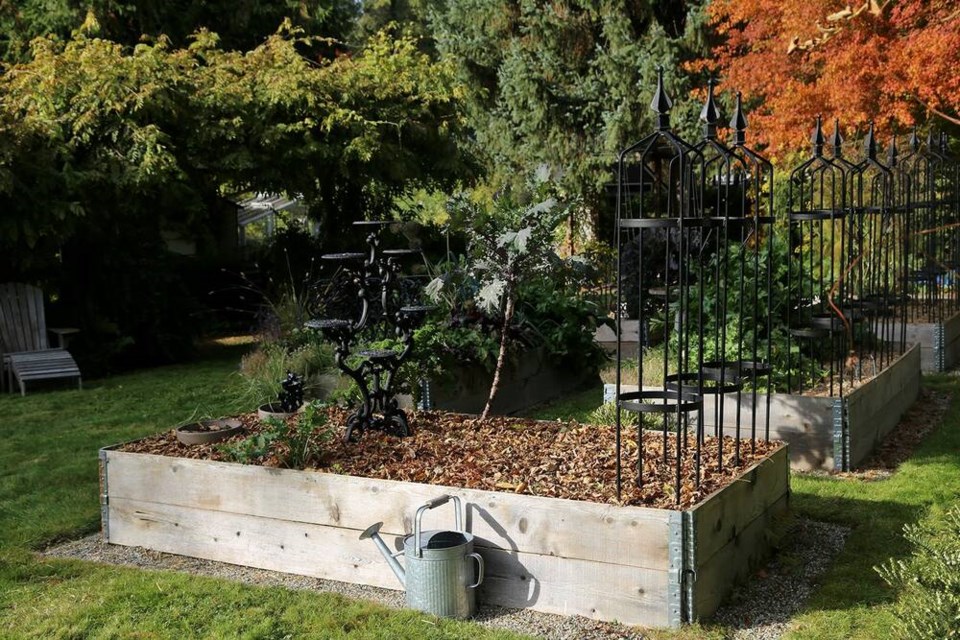For many reasons, we’ve decided to rest the winter garden beds this year. This summer was unseasonably busy, and my instincts tell me to rest and recharge.
Instead of attaching cold frames and fleeced hoops to our raised beds, we are fortifying them with organic nourishment, dressing them well for winter, and leaving them to slumber until spring. We are deferring to nature’s logic.
We will be doing much the same ourselves – hunkering down in the low light of winter, having first stocked our pantry and freezer with homegrown and locally produced sustenance, and set aside layers of protection from the cold.
Growing food under cover throughout the winter is a privilege, made possible through mechanical intervention and the sourcing of cold-hardy and native seed stock. We will still grow winter greens in containers, under cover of the eaves and kitchen patio roof, but there will be no cold-sweetened root vegetables or beautiful jewel-coloured bitter lettuces this season. I will rely on local farmers markets for those.
Nature’s logic suggests adding a generous layer of compost to fall gardens, allowing the slow burn of cold rain and melting snow to wash away unwanted salts and facilitate the workhorse biology that eats, poops and decomposes invisibly within the soil food web’s miraculous trophic cycle.
It is good practice to dress produce beds for winter by chopping and dropping the above-ground parts of spent rooted plants, and also adding chopped greenery from elsewhere in the garden. A thick layer of recycled or new clean chopped straw might come next, and if available, add a final layer of deciduous leaves, and/or a cover crop of winter rye or peas, or my personal favourite: mustards.
The ultimate treatment for winter beds is a dose of live and bioactive worm castings, or as Terra Flora Organics owner and artisanal soil farmer Andrew Couzens describes them, “fungal dominant.” Vermicast, a.k.a. “worm poop,” is super food for the garden, but only if the biology isn’t dead due to non-porous or stale-dated packaging.
Couzens recommends sprinkling one cubic foot or so (per 4x8-foot bed) of bioactive worm castings between winter garden mulch layers, as a means of slow-feeding soil biology. Incorporating worm castings into the mix before covering with a final layer of straw or leaves will redouble the beneficial microbes and provide essential humic and folic acids.
We have never added uncomposted animal manure of any kind directly to our garden beds, though we do add 18-24 month-aged, thermophilic and vermicast enriched organic compost that includes animal manure in its original recipe. This year however, having taken the decision to fallow our beds, we are adding a base layer of organic chicken manure (bedding) to the winter dressing.
A reassuring body of research conducted by reputable institutions suggests that pathogens like salmonella, associated with poultry products, do not survive beyond 120 days in the soil, particularly not in cold climates. I am confident that, by they time our well-fed and rested soil warms again in 180 days or so, it will be packed with organic nutrition, and safe for planting and sowing spring crops.
Vermicast and vermicompost are produced and available locally. Buy fresh from the source if possible.
The nested stack of five-gallon buckets that we store behind the house has done yeomen’s work throughout the seasons, making urban farming a possibility for us and for friends who lend. One bucket holds slightly less than one cubic foot of soil, compost, castings, or mulch, making garden math easy and small vehicle transport a breeze.
Laura Marie Neubert is a West Vancouver-based urban permaculture designer. Follow her on Instagram @upfrontandbeautiful, learn more about permaculture by visiting her Upfront & Beautiful website or email your questions to her here.
For a taste of permaculture, watch the video below:



